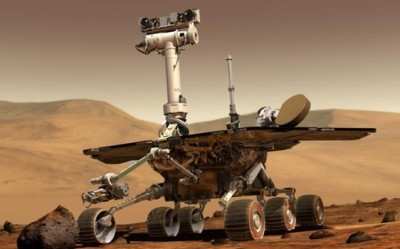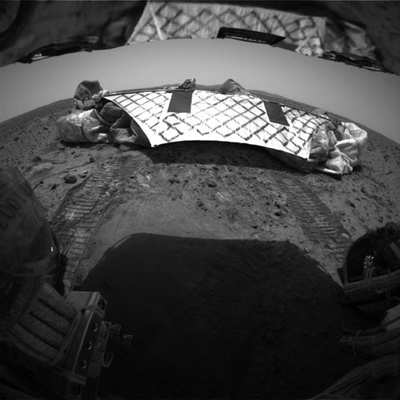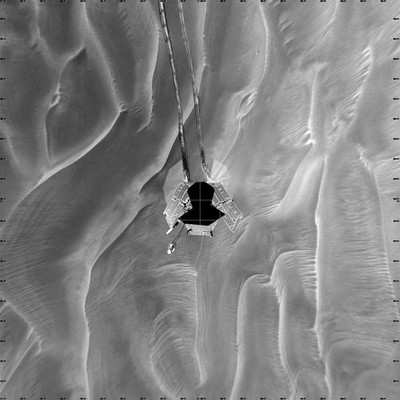JPL Team Says Rovers Are Well Suited To The Cloud Concept
The project team that built and operates the Mars rovers Spirit
and Opportunity has become the first NASA space mission to use
cloud computing for daily mission operations.

Spirit Rover Artist's Rendering
Cloud computing is a way to gain fast flexibility in computing
ability by ordering capacity on demand -- as if from the clouds --
and paying only for what is used. NASA's Mars Exploration Rover
Project moved to this strategy last week for the software and data
that the rovers' flight team uses to develop daily plans for rover
activities. NASA's Jet Propulsion Laboratory, Pasadena, CA, which
manages the project, gained confidence in cloud computing from
experience with other uses of the technology, including public
participation sites about Mars exploration.
"This is a change to thinking about computer capacity and data
storage as a commodity like electricity, or even the money in your
bank account," said JPL's John Callas, rover project manager. "You
don't keep all your money in your wallet. Instead you go to a
nearby ATM and get cash when you need it. Your money is safe, and
the bank can hold as much or as little of the money as you want.
Data is the same way: You don't need to have it on you all the
time. It can be safely stored elsewhere and you can get it anytime
via an Internet connection.
"When we need more computing capacity, we don't need to install
more servers if we can rent more capacity from the cloud for just
the time we need it. This way we don't waste electricity and air
conditioning with servers idling waiting to be used, and we don't
have to worry about hardware maintenance and operating system
obsolescence."

Spirit Rover NASA Image
Spirit and Opportunity landed on Mars in January 2004 for what
were planned as three-month missions. Bonus, extended missions have
continued for more than six years. Opportunity is currently active,
requiring daily activity plans by a team of engineers at JPL, and
scientists at many locations in North America and Europe. Spirit
has been silent since March 2010 and is believed to be in a
low-power hibernation mode for the Martian winter.
"The rover project is well suited for cloud computing," said
Khawaja Shams, a JPL software engineer supporting the project. "It
has a widespread user community acting collaboratively. Cloud
enables us to deliver the data to each user from nearby locations
for faster reaction time." Also, the unexpected longevity of the
mission means the volume of data used has outgrown the systems
originally planned for handling and sharing data, which makes the
virtually limitless capacity of cloud computing attractive.
JPL collaborated with the cloud team of Amazon.com Inc.,
Seattle, to plan and implement the use of cloud computing in the
Mars Exploration Rover Project's daily operations. JPL developed
the rover project's activity-planning software, called Maestro.

Opportunity Rover NASA Image
"We have worked closely with multiple cloud vendors since 2007
to learn the best ways to gain the advantages of cloud computing,"
said Tomas Soderstrom, chief technology officer for the JPL Office
of the Chief Information Officer. "To implement JPL CIO Jim
Rinaldi's vision of renting instead of buying capacity, we
pragmatically look past the hype about cloud computing to find the
practical, cost-efficient real mission applications. The Mars
Exploration Rover project's use of clouds is one example of this
results-oriented partnership. More will follow."
In another early use of cloud computing, JPL worked with the
cloud team at Google in Mountain View,CA. The Google cloud served a
project in which JPL and computer science students at the
University of California, San Diego, developed an educational
application enabling fifth- and sixth-graders to tag labels onto
images from Mars spacecraft.
In addition to establishing a private cloud and working with
Amazon, Google and Microsoft, JPL has also collaborated with other
vendors of public cloud computing. Soderstrom said, "We defined a
'cloud-oriented architecture' to use clouds as an extension of our
own resources and to run the computing and storage where it is most
appropriate for each application."

The extended missions of Spirit and Opportunity have provided a
resource for testing innovations during an active space mission for
possible use in future missions. New software uploads giving the
rovers added autonomy have been one example, and cloud computing is
another. JPL is currently building and testing NASA's next Mars
rover, Curiosity, for launch in late 2011 in the Mars Science
Laboratory mission. This rover will land on Mars in August
2012.
Shams said, "The experience we gain using cloud computing for
planning Opportunity's activities may be valuable when Curiosity
reaches Mars, too."
 Airbus Racer Helicopter Demonstrator First Flight Part of Clean Sky 2 Initiative
Airbus Racer Helicopter Demonstrator First Flight Part of Clean Sky 2 Initiative Diamond's Electric DA40 Finds Fans at Dübendorf
Diamond's Electric DA40 Finds Fans at Dübendorf ANN's Daily Aero-Term (04.23.24): Line Up And Wait (LUAW)
ANN's Daily Aero-Term (04.23.24): Line Up And Wait (LUAW) NTSB Final Report: Extra Flugzeugbau GMBH EA300/L
NTSB Final Report: Extra Flugzeugbau GMBH EA300/L Classic Aero-TV: 'Never Give Up' - Advice From Two of FedEx's Female Captains
Classic Aero-TV: 'Never Give Up' - Advice From Two of FedEx's Female Captains






